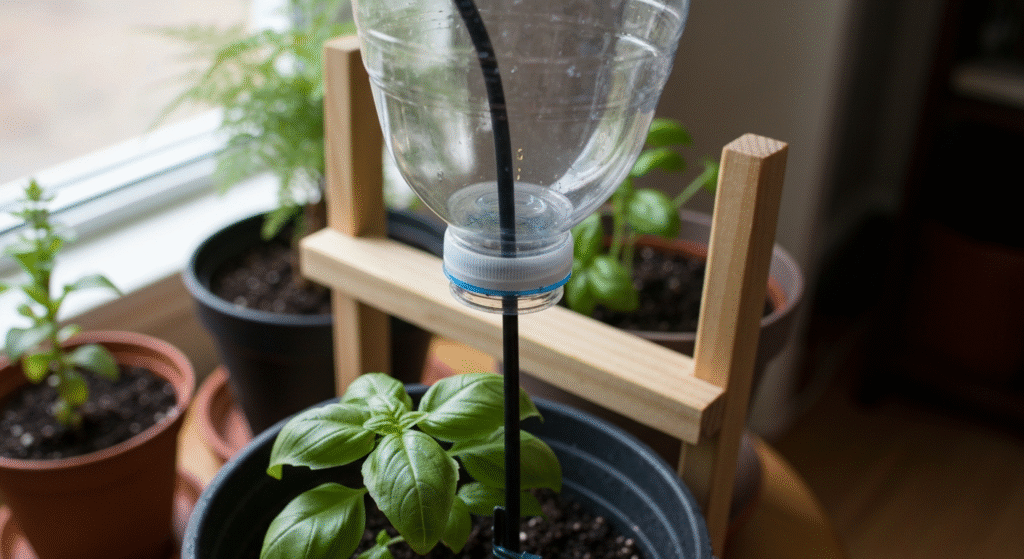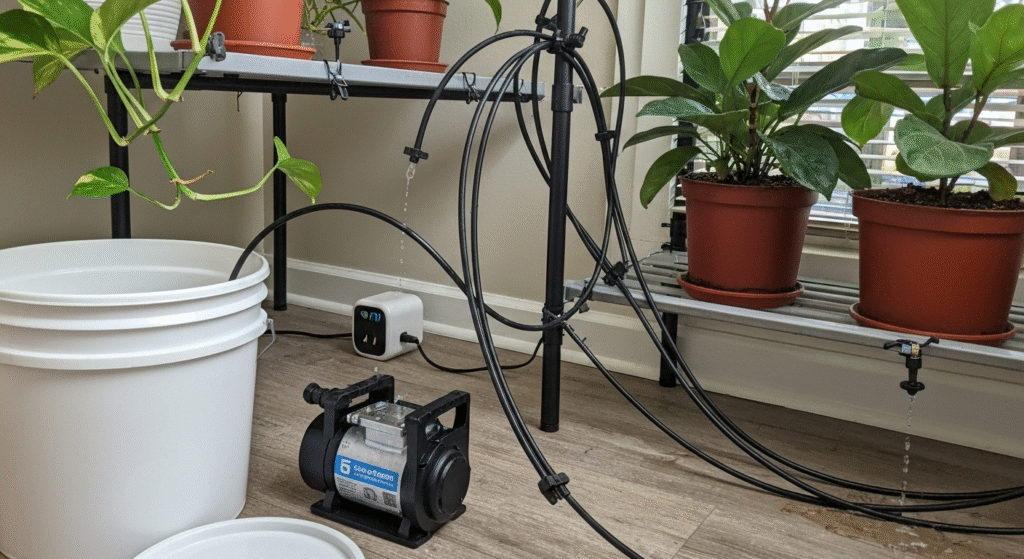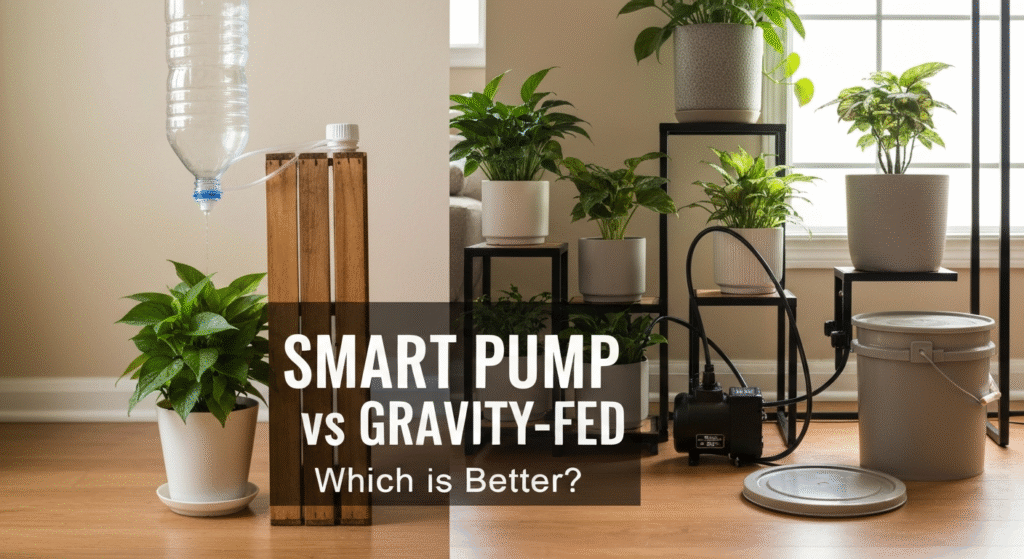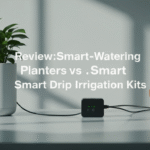Trying to keep indoor plants perfectly watered can feel like a full-time job. We’ve all been there: one plant is bone dry, while its neighbor is waterlogged. Finding that perfect balance is tricky, especially when you’re busy or away from home. This challenge leads many of us to look for an automated solution. The two main contenders? The wonderfully simple gravity-fed system and the powerful, high-tech smart pump.
Deciding between them isn’t just about cost. It’s about the number of plants you have, the level of control you want, and your tolerance for tinkering. One system is silent and simple, the other is precise and scalable. As an indoor gardener who has tried—and failed, and succeeded—with both, my goal is to help you skip the frustration and find the right setup for your home.
Hello! I’m Priya. My journey into automated watering wasn’t exactly planned. About five years ago, I was struggling to keep my indoor herb garden alive during work trips. I started with simple gravity-fed bottle drippers, but I kept coming home to either flooded trays or dried-out plants. This frustration sent me deep into the world of smart home gardening, and I’ve spent the last few years obsessively testing different pumps, sensors, and gravity setups in my own apartment. I’m here to share what I’ve learned—the successes, the (many) failures, and the practical pros and cons—to help you find the right system for your plants.
What Exactly is a Gravity-Fed Watering System?

At its core, a gravity-fed system is beautifully simple. It uses the power of gravity—and nothing else—to move water from a reservoir to your plants. The only real requirement is that your water source must be placed at a higher level than your plant’s soil. The height difference creates water pressure (often called “head pressure”) that pushes the water down through thin tubes to your plants.
When I first started, this was my go-to. My very first setup was a 2-liter soda bottle, with a few tiny holes poked in the cap, turned upside down and propped on a shelf above my basil. It was… inconsistent, to say the least.
From there, I graduated to more “official” systems, which usually fall into a few categories:
- Watering Spikes/Globes: These are the simplest version. You fill a glass globe or attach a plastic spike to a water bottle, then stick it into the soil. Water slowly seeps out as the soil dries.
- Terracotta Spikes (like Blumat): These are a bit more clever. A terracotta cone is pushed into the soil, and a thin tube connects it to a reservoir. As the soil dries, it pulls water through the porous terracotta. When the soil is wet, it stops pulling.
- Reservoir-and-Tube Kits: This involves a larger water container (like a bucket or bag) placed on a high shelf, with one or more thin tubes running down to drippers staked into each pot.
The appeal is obvious: it’s simple, it’s cheap, and it requires zero electricity.
The Good: Pros of Going with Gravity
When I used gravity-fed systems, I loved them for a few key reasons.
- Completely Silent: This is a huge plus for living rooms or bedrooms. There are no motors, no hums, no clicks. Just the silent, slow movement of water.
- No Electricity Needed: This is the system’s superpower. It’s “off-grid.” You can place plants on a high shelf, in a corner far from an outlet, or in a sunroom without worrying about power cords. It also means a power outage won’t stop your plants from getting watered.
- Very Low Cost: You can build a DIY system for next to nothing. Even the most popular commercial kits, like Blumat stakes, are very affordable to get started with.
- Gentle Watering: The slow, steady drip is fantastic for plants that hate being drenched. It mimics a slow, gentle rain, allowing the soil to absorb water evenly without compacting.
The Bad: Common Problems with Gravity-Fed Setups
My love for gravity systems faded as my plant collection grew. I ran into problems—problems that I now know are extremely common.
- Inconsistent Flow: This is the biggest issue. The flow rate is entirely dependent on the water level in your reservoir. When the bucket is full, the pressure is high, and the water flows faster. When the bucket is half-empty, the pressure drops, and the flow slows to a trickle. This made it impossible to get consistent watering.
- Clogging is a Constant Battle: The drippers and tubes are tiny. I spent more time cleaning drippers than I did gardening some weeks. Tiny bits of soil, dust, or (especially) mineral buildup from hard tap water will clog the system in a heartbeat, stopping the flow to one or more plants.
- Limited Pressure and Placement: You have no flexibility. The water must be above the plants. This means finding a high shelf or mounting a reservoir on the wall, which isn’t always practical or attractive. You also can’t “push” water very far; it struggles to service a long row of plants.
- Refill Hassles: Because the reservoir must be high, refilling it can be a chore. I got tired of climbing on a stool with a heavy watering can just to top off the bucket.
- Difficult to Scale: A gravity system is okay for two or three plants. Trying to water 20 plants this way is a plumbing nightmare of tubes, flow-balancing issues, and endless clog-hunting.
What is a “Smart Pump” in an Indoor Garden?
After one too many vacations resulted in a plant graveyard, I bought my first 12V diaphragm pump. It was a total game-changer for reliability.
A smart pump system takes an active approach. It uses a small electric pump to push water from a reservoir to your plants. Because the pump creates its own pressure, your reservoir can be anywhere—on the floor, under a cabinet, or in a closet.
The “smart” part comes from how you control it. A pump that runs 24/7 would drown your plants. You have to tell it when to turn on and off.
- Simple Timers: The easiest method. I started by plugging my pump into a basic digital outlet timer, the kind you use for holiday lights. I set it to run for 1 minute, twice a week.
- Smart Plugs: This is a step up. You plug the pump into a Wi-Fi smart plug (like Kasa, Wyze, or Meross) and control it from an app on your phone. This lets you set complex schedules (e.g., “30 seconds every 3 days”) or even turn it on manually from work.
- Sensor-Based Systems: This is the truly “smart” setup. The pump is connected to soil moisture sensors placed in your pots. The system only turns the pump on when the sensor reports the soil is actually dry. This is the ultimate “set it and forget it” solution.
The Wins: Why Smart Pumps Shine
Switching to a smart pump solved almost every problem I had with my gravity system. For any serious indoor gardener, the benefits are huge.
- Precision and Control: You decide exactly how much water your plants get and when. A 15-second pump cycle delivers a precise amount of water. This is critical for finicky plants like calatheas that want to be just right or for succulents that need a specific soak-and-dry cycle.
- Consistent Pressure: The pump’s flow is the same whether your 5-gallon reservoir is full or nearly empty. Every plant on the line gets the same amount of water, every time.
- Total Reservoir Flexibility: This was a huge quality-of-life improvement. My 5-gallon water bucket now sits on the floor, hidden behind a curtain. I just drop the intake tube in and forget about it. No more climbing on stools.
- Amazing Scalability: This is where pumps are unbeatable. One good pump can easily power a drip irrigation system for dozens of plants. My current setup waters over 30 plants on three different shelves, all running from a single pump and reservoir. That’s simply impossible with a gravity-fed system.
The Drawbacks: What to Know Before You Buy
Of course, it’s not a perfect solution. There are trade-offs to be aware of.
- Upfront Cost: A smart pump system costs more. You need the pump (submersible or diaphragm), tubing, drippers, a power supply, and a smart controller (even a simple smart plug adds to the cost).
- Noise: They are not silent. Submersible pumps (which sit inside the water) are very quiet, often just a low hum. Diaphragm pumps (which sit outside) are a bit louder, making a distinct “thump-thump-thump” or buzzing sound when they run. It’s only for a minute or two, but it’s noticeable in a quiet room.
- Needs Electricity: This is the obvious one. You need an outlet nearby. And if your power goes out for a few days while you’re on vacation, your plants aren’t getting watered.
- More Complexity: More moving parts means more things that can (though rarely do) break. The pump motor could fail, the smart plug could lose Wi-Fi, or an advanced sensor could malfunction. It’s more complex than a bucket and a tube.
Head-to-Head Comparison: Smart Pump vs. Gravity-Fed
I’ve spent years tracking these factors in my own setups, from my first leaky bottle to my current multi-shelf smart system. Here’s a simple breakdown of how I see the practical differences.
A Quick Note on This Table: This is based on my 5+ years of hands-on experience in a typical apartment setting. Your results might vary based on your specific plants or home, but this is what I’ve found to be true time and time again.
| Feature | Gravity-Fed System | Smart Pump System |
| Water Pressure | Low & Inconsistent (decreases as reservoir empties) | High & Consistent (strong flow until reservoir is empty) |
| Best For | 1-5 plants, short vacations (3-7 days), no-power areas | 5+ plants, long-term automation, picky plants |
| Typical Cost | Very Low ($5 – $30) | Moderate ($30 – $100+) |
| Setup Time | Quick (15-30 mins) | Moderate (1-3 hours for a clean setup) |
| Noise Level | Silent | Low to Moderate (pump hum or click) |
| Reliability | Low to Moderate (prone to clogs, flow changes) | High (when set up correctly) |
| Power Needed? | No | Yes |
| My Big Takeaway | Great for a simple “getaway” solution for a few plants. | The only choice for serious, long-term automation. |
Which System is Right for Your Indoor Garden?
This is the real question. The “best” system is the one that fits your life, your budget, and your plants.
Choose a Gravity-Fed System if…
- You have just a few plants (I’d say five or fewer) that are all close together.
- You need a simple, temporary solution for a short vacation (3-7 days).
- Your plants are in a spot with no power outlet nearby.
- You are on a very tight budget and love a simple, low-tech solution.
- You are extremely sensitive to noise and want a completely silent setup.
My Experience: I still use a gravity-fed system! I have a single, large peace lily in my living room, far from any outlet. It has a single terracotta Blumat spike connected to a decorative water bottle hidden behind it. It’s the perfect, simple solution for that one plant.
Choose a Smart Pump System if…
- You have a large collection of plants (5 or more) or plants on multiple shelves.
- You want true, long-term automation where you can “set it and forget it” for weeks.
- You want to use soil moisture sensors for on-demand watering.
- Your plants are finicky (like calatheas, ferns, or succulents) and need very precise watering schedules.
- You travel frequently or for long periods (a week or more).
My Experience: My main plant shelf, with all my aroids, herbs, and propagation projects, runs on a smart pump. It’s connected to a smart plug that I have scheduled in an app. I just check the 5-gallon reservoir level once every few weeks. I couldn’t manage this collection without it.
My Experience: Building Your First Smart Pump System

Getting started with a pump can feel daunting, but the basic setup is simpler than you’d think. After a lot of trial and error, here are the core parts I use for all my new setups.
The Essential Parts List
- The Reservoir: Don’t overthink this. I use a 5-gallon, food-safe bucket with a lid. You can get them from any hardware store. The lid is key—it stops evaporation, keeps dust and debris out, and prevents algae from growing in the water.
- The Pump: You have two main choices.
- Submersible: Sits inside the water. They are very quiet but can be a pain to access for maintenance.
- Diaphragm: Sits outside the water, with an “in” tube and an “out” tube. I personally prefer these. They’re a bit louder, but I find them easier to access and troubleshoot. A simple 12V pump is plenty for most indoor setups.
- The Tubing: 1/4-inch black vinyl tubing is the standard. Black is important—clear tubes will grow algae inside them. And trust me, buy more than you think you need.
- The “Brain” (Controller):
- The Easiest Start: A Wi-Fi smart plug. Plug your pump’s power adapter into it. You get full control from your phone to set a schedule like, “Turn on for 45 seconds, every 3 days.”
- The Advanced Upgrade: A soil moisture sensor kit. These kits come with sensors you stick in the pots and a relay that controls the pump. It only waters when the plant needs it.
- The Drippers: You need adjustable drip emitters. These are little stakes you put in each pot that let you control the flow rate for each plant. This is crucial, as your thirsty fern will need more water than your snake plant.
A Mistake I Made (And How to Avoid It)
My first big pump setup was a disaster. I spent hours running tubes, plugged it in, and it worked perfectly! Then, when the pump shut off, it created a siphon effect. Water kept flowing, slowly and silently, draining my entire 5-gallon reservoir onto my hardwood floor overnight.
The Fix: You must prevent backflow, also known as siphoning. You have two easy options:
- The Anti-Siphon Hole: Take the main water line (the one coming from the pump) and poke a tiny pinhole in it. Position this hole inside the reservoir, just above the water line. When the pump shuts off, it will suck in air through this hole, breaking the siphon.
- A Check Valve: This is a small, one-way valve you install in the line. It physically stops water from flowing backward.
Don’t skip this step. I learned this lesson the hard, wet way so you don’t have to.
Troubleshooting Common Watering Problems
No matter which system you choose, you’ll need to fine-tune it. Here are the issues I see most often.
“My Gravity System Clogged… Again!”
This was my number one problem for a year.
- Use Filtered Water: If you have hard tap water, it will clog your system with mineral deposits. Use filtered, distilled, or even just old aquarium water.
- Add a Pre-filter: Put a small piece of sponge or cheesecloth at the intake end of the tube inside your reservoir. This stops any dust or debris from getting in.
- Clean Regularly: Once a month, flush your drippers by soaking them in a cup of white vinegar. This dissolves any mineral buildup.
“My Smart Pump is Too Strong/Weak!”
- Too Strong: Your pump is pushing out too much water. The best fix is to add more drippers to your line. This divides the flow. You can also buy adjustable-flow pumps or use adjustable drippers and turn them to a lower setting.
- Too Weak: Check for kinks in your 1/4″ tubing. If that’s not it, your pump’s “head height” (the vertical distance it can push water) might be too low. Check the pump’s specs. A pump rated for a 3-foot head height cannot push water to a 5-foot-high shelf.
“Help! My Plants are Too Wet/Too Dry!”
This is a calibration problem, not a system failure. Don’t just “set it and forget it” on day one.
- Watch Your Plants: For the first week, check the soil with your finger before the system is scheduled to run. Is it still damp? Add another day between waterings. Is it bone dry? Increase the watering time (e.g., from 30 seconds to 45 seconds).
- Check Your Drippers: Make sure the adjustable drippers are set right. Your big monstera might need the dripper wide open, while the small succulent next to it needs it at a bare trickle.
- Understand Your Plants: An automated system doesn’t change a plant’s basic needs. It’s just a tool. If you’re not sure how wet your plants should be, a good, simple resource can make all the difference. This guide on watering indoor plants from the University of Maryland Extension is a great, no-nonsense article I often share with friends.
Frequently Asked Questions (FAQs)
1. Can I use a gravity-fed system for hydroponics?
Generally, no. Hydroponics (like deep-water culture or nutrient-film technique) requires active, consistent water movement and oxygenation. A gravity-fed dripper is too slow and doesn’t circulate the water. You’ll need a pump for any real hydroponic setup.
2. How loud are smart pumps?
It really depends on the type. The submersible pumps I’ve used are just a quiet hum, softer than a refrigerator. My current diaphragm pump is a low, rhythmic “thump-thump-thump.” I can hear it if the room is silent, but it’s not loud enough to be disruptive, and it only runs for about a minute.
3. Can I connect a smart pump to my smart home (Alexa/Google)?
Yes, easily! This is my favorite part. If you use a Wi-Fi smart plug (like Kasa, which is what I use), you can name it “Water Plants.” Then you can just say, “Alexa, water the plants,” and the pump will turn on for its scheduled time. It’s also great for putting it on a simple schedule in the app.
4. How often do I need to refill the reservoir?
This depends on your plants, the season, and your reservoir size. In my 30-plant setup, my 5-gallon (about 19-liter) bucket lasts about 2-3 weeks in the summer when the plants are thirsty. In the winter, it can last 3-4 weeks. This is the real freedom of a smart pump system.
Conclusion: Your Plants, Your Choice
So, what’s the bottom line? There’s no single “best” answer. The best system is the one that solves your specific problem.
If you have a few plants and just need to get through a long weekend, a simple, silent gravity-fed system is a perfect, low-cost solution. I still use them for isolated plants.
But, if you’re like me, and your collection is growing, or you want true, long-term freedom from the daily “is it time to water?” question, a smart pump system is a worthy upgrade. The precision, scalability, and flexibility it offers have been, for me, the key to managing a large indoor garden without it taking over my life.
Starting with gravity is a great way to learn. Graduating to a pump is when you get serious about automation. The most important thing is to choose the solution that keeps you enjoying the hobby.


